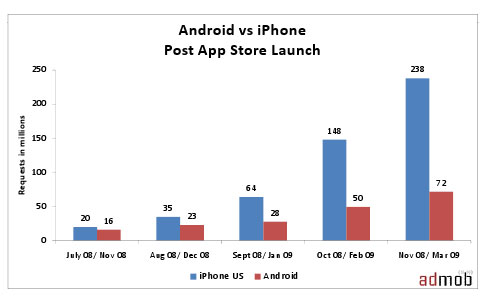App stores to thank for iPhone and Android growth

AdMob's March 2009 Mobile Metrics Report was released today, and this month's report focuses on the Android and iPhone platforms. It's clear that the popularity of Android has been growing quickly since its launch. The HTC Dream (G1) is the No. 4 smartphone after the iPhone, Blackberry Curve, and Blackberry Pearl, and it produces 2 percent of AdMob's U.S. requests.
This month's report compared the growth of Android to the growth of iPhone. AdMob is the world's largest mobile advertising platform. It stores and analyzes data from every ad request, impression, and click for the 6,000 mobile Web sites and 1,000 apps it serves ads for around the world.
AdMob found that both iPhone and Android grew more quickly than the market, but iPhone left Android in the dust -- which is no surprise. Whereas U.S. Android traffic grew an average of 47 percent per month since it launched five months ago, iPhone traffic grew an average of 88 percent per month during the five months since Apple launched its App Store.
More than half of Android and iPhone requests came from applications that month. AdMob received eight times more traffic from iPhones in the U.S. than from Android.
But Android is growing quickly. The Android OS has 6 percent of the U.S. smartphone market and is tied with Palm as the fourth-largest OS. The HTC Dream (G1) was the No. 10 device in the U.S. in March.
There are many factors to take into account though, such as the huge marketing campaigns Apple has. Also, the Apple numbers look at both iPhone and iPod touch, which changes things a bit.
AdMob product marketer Mike F. said in blog post today that these latest numbers are logical.
"...When you consider that there are 1 to 2 million of the G1 sold in the U.S. compared to the approximately 15 million of the iPhone sold in the U.S. today, the ratio makes sense. As more Android phones launch around the world and the Android OS moves to other devices such as netbooks and Mobile Internet Devices, this gap is likely to close."
Check out the full AdMob report here.
